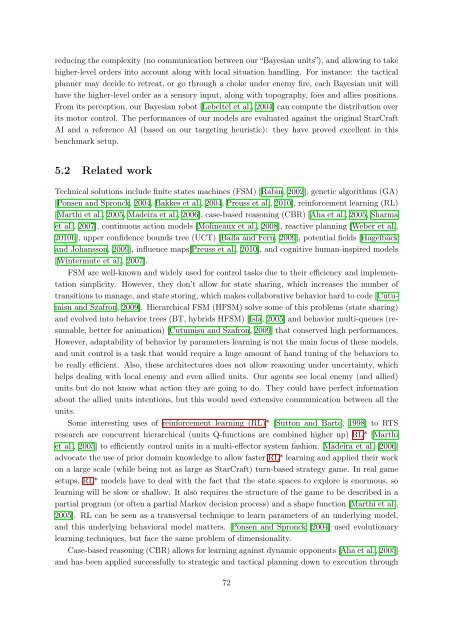Bayesian Programming and Learning for Multi-Player Video Games ...
Bayesian Programming and Learning for Multi-Player Video Games ...
Bayesian Programming and Learning for Multi-Player Video Games ...
Create successful ePaper yourself
Turn your PDF publications into a flip-book with our unique Google optimized e-Paper software.
educing the complexity (no communication between our “<strong>Bayesian</strong> units”), <strong>and</strong> allowing to take<br />
higher-level orders into account along with local situation h<strong>and</strong>ling. For instance: the tactical<br />
planner may decide to retreat, or go through a choke under enemy fire, each <strong>Bayesian</strong> unit will<br />
have the higher-level order as a sensory input, along with topography, foes <strong>and</strong> allies positions.<br />
From its perception, our <strong>Bayesian</strong> robot [Lebeltel et al., 2004] can compute the distribution over<br />
its motor control. The per<strong>for</strong>mances of our models are evaluated against the original StarCraft<br />
AI <strong>and</strong> a reference AI (based on our targeting heuristic): they have proved excellent in this<br />
benchmark setup.<br />
5.2 Related work<br />
Technical solutions include finite states machines (FSM) [Rabin, 2002], genetic algorithms (GA)<br />
[Ponsen <strong>and</strong> Spronck, 2004, Bakkes et al., 2004, Preuss et al., 2010], rein<strong>for</strong>cement learning (RL)<br />
[Marthi et al., 2005, Madeira et al., 2006], case-based reasoning (CBR) [Aha et al., 2005, Sharma<br />
et al., 2007], continuous action models [Molineaux et al., 2008], reactive planning [Weber et al.,<br />
2010b], upper confidence bounds tree (UCT) [Balla <strong>and</strong> Fern, 2009], potential fields [Hagelbäck<br />
<strong>and</strong> Johansson, 2009], influence maps[Preuss et al., 2010], <strong>and</strong> cognitive human-inspired models<br />
[Wintermute et al., 2007].<br />
FSM are well-known <strong>and</strong> widely used <strong>for</strong> control tasks due to their efficiency <strong>and</strong> implementation<br />
simplicity. However, they don’t allow <strong>for</strong> state sharing, which increases the number of<br />
transitions to manage, <strong>and</strong> state storing, which makes collaborative behavior hard to code [Cutumisu<br />
<strong>and</strong> Szafron, 2009]. Hierarchical FSM (HFSM) solve some of this problems (state sharing)<br />
<strong>and</strong> evolved into behavior trees (BT, hybrids HFSM) [Isla, 2005] <strong>and</strong> behavior multi-queues (resumable,<br />
better <strong>for</strong> animation) [Cutumisu <strong>and</strong> Szafron, 2009] that conserved high per<strong>for</strong>mances.<br />
However, adaptability of behavior by parameters learning is not the main focus of these models,<br />
<strong>and</strong> unit control is a task that would require a huge amount of h<strong>and</strong> tuning of the behaviors to<br />
be really efficient. Also, these architectures does not allow reasoning under uncertainty, which<br />
helps dealing with local enemy <strong>and</strong> even allied units. Our agents see local enemy (<strong>and</strong> allied)<br />
units but do not know what action they are going to do. They could have perfect in<strong>for</strong>mation<br />
about the allied units intentions, but this would need extensive communication between all the<br />
units.<br />
Some interesting uses of rein<strong>for</strong>cement learning (RL)* [Sutton <strong>and</strong> Barto, 1998] to RTS<br />
research are concurrent hierarchical (units Q-functions are combined higher up) RL* [Marthi<br />
et al., 2005] to efficiently control units in a multi-effector system fashion. Madeira et al. [2006]<br />
advocate the use of prior domain knowledge to allow faster RL* learning <strong>and</strong> applied their work<br />
on a large scale (while being not as large as StarCraft) turn-based strategy game. In real game<br />
setups, RL* models have to deal with the fact that the state spaces to explore is enormous, so<br />
learning will be slow or shallow. It also requires the structure of the game to be described in a<br />
partial program (or often a partial Markov decision process) <strong>and</strong> a shape function [Marthi et al.,<br />
2005]. RL can be seen as a transversal technique to learn parameters of an underlying model,<br />
<strong>and</strong> this underlying behavioral model matters. Ponsen <strong>and</strong> Spronck [2004] used evolutionary<br />
learning techniques, but face the same problem of dimensionality.<br />
Case-based reasoning (CBR) allows <strong>for</strong> learning against dynamic opponents [Aha et al., 2005]<br />
<strong>and</strong> has been applied successfully to strategic <strong>and</strong> tactical planning down to execution through<br />
72


